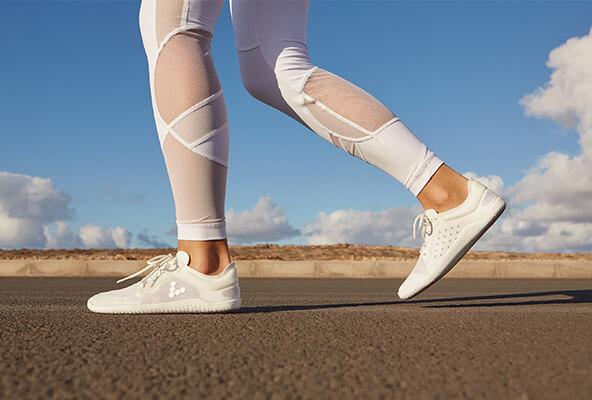Pronation and Supination are natural and essential for healthy feet and ankles. The truth is the natural functional foot is an incredible piece of kit and is designed to pronate and supinate when you walk and run. Your movement skill shapes your anatomy, you are how you move. Pronation and Supination are necessary to shock absorption and stability mechanisms for healthy functioning feet and ankles.
What about pronation and running shoes?
It is very normal to go to your local running store to have your gait checked and shoes prescribed according to your level of pronation and foot type. But does controlling pronation reduce injuries? According to research funded by Nike in 2010, “our current approach of prescribing in-shoe pronation control systems on the basis of foot type is overly simplistic and potentially injurious.” Further “It is noteworthy that every runner who trained in the motion control shoe with a highly pronated foot posture reported an injury compared with only 2 runners in this same foot posture category wearing the neutral shoe” (1). That’s right, shockingly every runner prescribed a shoe designed to control their severe overpronation got injured. Pronation control is not the answer! 2015 research concluded “there is no evidence that foot pronation (eversion) is a variable responsible for running injuries”. And “despite the supposed advances in footwear over the last 40 years, injury rates haven’t really changed”. (2)
Given they are natural, what are the right amounts of Pronation and Supination?
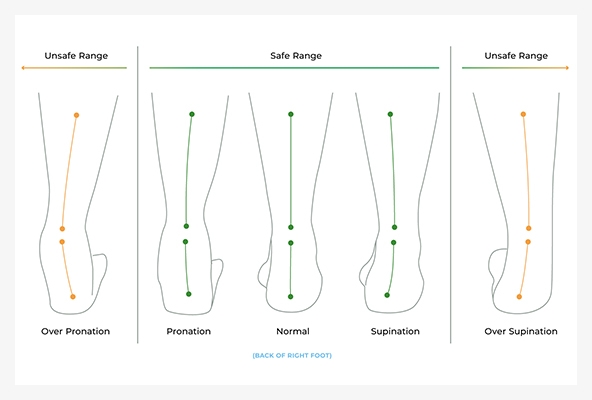

Pronation describes the movement of weight from the outside towards the inside. When the centre point of your bodyweight, known as your centre of mass, is moving inwards, you are pronating. Pronated defines one point in time. Pronated describes the centre of mass being on the inside of the midline of the foot. Stand and roll your feet inwards to feel pronation. When walking and running, pronation is a necessary part of the foot’s shock absorption mechanism, enabling the it to be a mobile adapter.
Supination describes the opposite journey to pronation, the movement of the centre of mass from the inside towards the outside. Anytime the centre of mass is moving outwards you are supinating. Supinated describes the centre of mass being outside the midline of the foot. Stand and roll your feet to the outside to feel supination. When walking and running, supination is a necessary part of the foot’s stability mechanism, enabling the foot to be a rigid lever.
Whilst they are natural, Pronation and Supination are complex dynamic movements. When walking, your body moves over our feet from heel to big toe and at the same time your weight moves inside and outside (and inside) of the midline of the foot. Over Pronation, where your centre of mass rolls inside your big toe, and excessive Supination, where your weight stays along the outside of your foot, occur when you have insufficient strength and mobility in your ankles, feet and toes to balance your centre of mass along the outside and inside of the midline.
When you walk with skilful natural technique, you will pronate and supinate as your bodyweight travels over your foot. It is natural to contact the floor just to the outside of the midline of the heel in a supinated position. Your weight moves inwards pronating as part of the body’s natural shock absorption mechanism. This encourages a smooth heel stroke before you roll outward supinating until contact is made through the balls of your feet, you then roll in again pronating across the balls and finally, as you leave the floor through the big toe and second toe, you roll outward and supinate.
Natural pronation and supination describe your weight moving inside and outside the midline of the foot. Your bodyweight is distributed half on the big toe and half on the other toes when you lift off into your next step. The human foot is a biomechanical marvel!
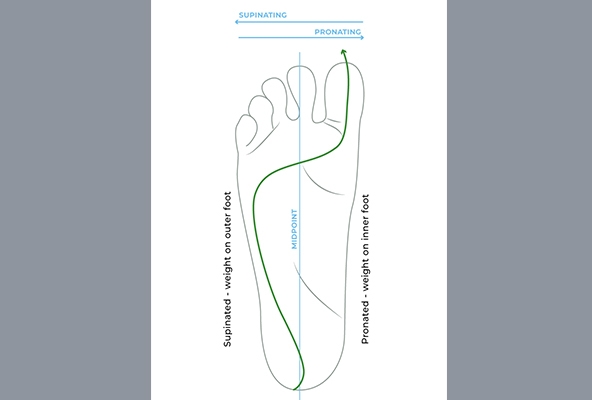

Above image shows Centre of Mass during Walking Gait
Overpronation and Excessive Supination
As the heel makes contact there are micro movements which make up pronation. The heel bone rolls towards the floor and inwards and the shin bone rotates inwards then forwards over the ankle. When these movements are lacking control due to weak ankles, weak extrinsic foot muscles and shoes with raised heels and narrow toe boxes the movements are larger and you overpronate i.e. your centre of mass travels too far inwards. Overpronation can cause and exacerbate heel, arch, ball and general foot pain as well as lead to bunions, neuromas, shin, knee, hip and back pain.
Metatarsus Atavicus If your first metatarsal, which ends at the ball of your big toe, is shorter than the second and in some cases hypermobile ie excessively flexible, the chances of over pronation are further increased as the ball of the big toe cannot stabilise the foot sufficiently and our centre of mass carries on moving inwards and off over the ball of the big toe rather than through the big and second toes. This over pronating movement pattern is often the result of feet excessively turned out and knees turned in and whilst it can also be affected by hip alignment and glute function, shoes change the way you move, and your body shape is determined by how you move.
Whilst a short first metatarsal may be genetic, first termed Metatarsus Atavicus by Dudley Morton in 1927 (3) who speculated it is a latent genetic trait, an atavism, characteristic of a chimp foot, shoes with narrow toe boxes are the catalyst which lead to pain and dysfunction and shoes and movement affect the development of our foot bones and function. In our experience people with a Morton’s foot structure are more likely to develop foot problems. Morton’s foot can lead to Hallux Valgus, when the big toe misaligns towards the other toes and eventually Bunions and Morton’s Neuroma’s (named after a different Morton to Morton’s foot!). Again, we believe shoes are the catalyst to problems. In our experience people with Morton’s foot who for example wear shoes with wide toe boxes are less likely to experience problems. If you have Morton’s foot, a wide toe box and stronger big toes (and all intrinsic and extrinsic muscles) may help to alleviate issues. As will improving your skill of standing and walking. Such problems rarely exist among barefoot populations.
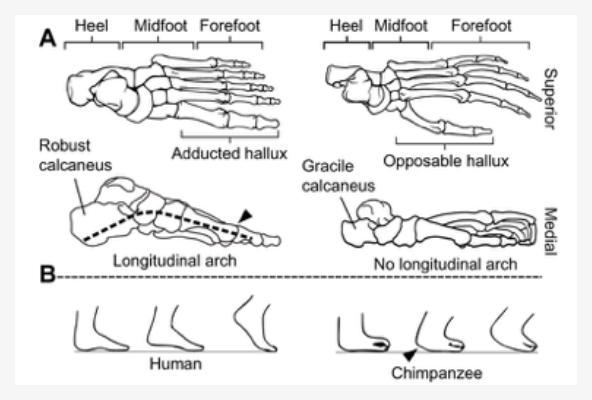

(4). Note the position of the ball of the big toe compared to the ball of the 2nd toe in the Human versus the Chimpanzee.
When the ankle is stiff and lacking mobility, you continue supinating. The centre of mass travels around the outside of the foot. If lack of ankle range is combined with stiff arches, limiting midfoot pronation, your full weight is concentrated entirely along the outside edge of your foot, on small delicate bones, and travels off through the outside toes. A rigid high arched foot lacks the mobility required to load through the balls of the big toe. This is excessive supination and can lead to metatarsal stress fractures and make you more susceptible to strains in the muscles and ligaments in your ankles and feet as well as knee, hip and back pain.
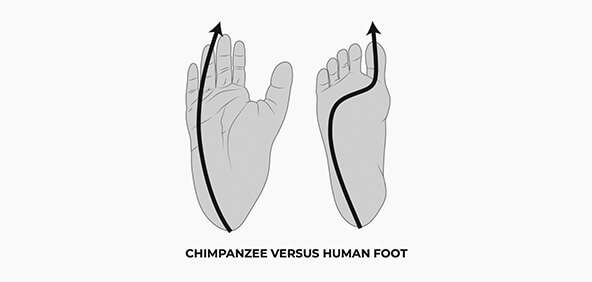

The chimp foot left is an example of excessive Supination, the weight travels around the outside of the foot. The human foot on the right shows natural Pronation and Supination.
How do shoes contribute to Overpronation and Supination?
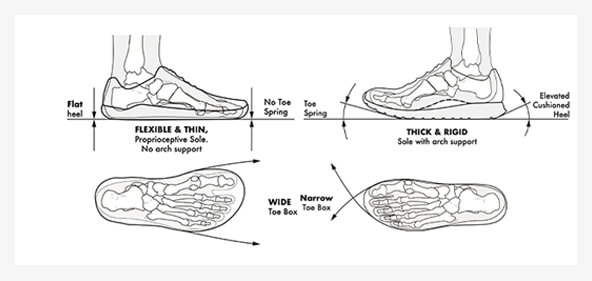

A wide toe box gives us the freedom to spread our toes and our centre of mass travels in the correct path forwards allowing for adaptation to undulating terrain. With a narrow toe box and squished toes, you have a greater likelihood of our centre of mass travelling too far inwards and overpronating or too far outwards and excessively supinating.
Toe Spring also affects foot function by holding the toes lifted off the ground making it impossible for them to act as stabilisers and the big toe as the anchor. Raised cushioned heels encourage a longer stride length and an excessive heel strike, (5) hitting the ground further back on the heel. It’s especially a problem during running, as the longer stride places more shock through the foot and into the knee. This heightened shock occurs despite shoe cushioning. The change in movement pattern caused by the high heel and excessive cushioning increases shock more than the cushioning counteracts it. Barefoot movement and movement in wide, ultra-thin, flexible footwear does not cause the same stress.
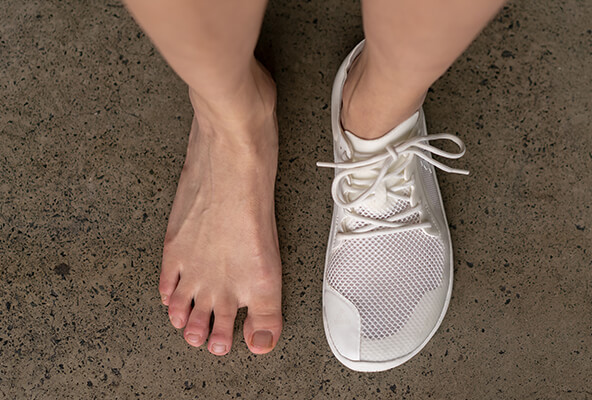

At Vivobarefoot we believe the foot has everything we need for walking and running. Whether you are over pronating or excessively supinating, we recommend everybody reconnects with their feet. By wearing Vivobarefoot footwear you are providing your body with more information regarding impact forces, this gives you a greater opportunity to balance and move more skilfully which can reduce injury potential not to mention maximising your enjoyment of walking and running. By practicing foot exercises, squats, jumping and other micro drills alongside learning to walk and run in wide, thin, flexible footwear with a more healthy and efficient technique, like upright posture and short strides landing under the body, you will eliminate many over pronation and supination issues. Our caution is to be mindful and listen to your body building up activity very slowly and carefully.
Conclusion
It is possible to train an overly pronating mobile foot to be stronger and more aligned and an overly supinating rigid foot be more mobile and shock absorbing. Wearing wide, thin, flexible shoes and practicing simple exercises such as toe strengthening, balancing on one leg, squats, calf raises and jumping help mobility and strength of ankles and feet. Most importantly, attempts to improve a dysfunctional foot with a motion control or stability shoe or orthotic is an example of treating symptoms. Most cases of poorly functioning feet are usually due to muscle imbalance. Keeping feet in rigid, immobile positions can further promote foot imbalance by not allowing the body to naturally correct the problem.
If you’re experiencing persistent pain and discomfort, consult a medical professional – it is rare, but some foot problems go beyond your choice of footwear, and it’s most important above all else to get a proper diagnosis for chronic issues.
1. The effect of three different levels of footwear stability on pain outcomes in women runners: a randomised control trial
Michael B Ryan,1 Gordon A Valiant,2 Kymberly McDonald,1 Jack E Taunton1 June 2010
Br J Sports Med 2011;45:715–721. doi:10.1136/bjsm.2009.069849
2. Running shoes and running injuries: mythbusting and a proposal for two new paradigms: ‘preferred movement path’ and ‘comfort filter’
Nigg BM, et al. Br J Sports Med 2015;0:1–6. doi:10.1136/bjsports-2015-095054
3. Metatarsus Atavicus
Dudley Joy Morton J Bone Joint Surg 1927;9:531
4.Rethinking the evolution of the human foot: insights from experimental research
Nicholas B. Holowka, Daniel E. Lieberman. Journal of Experimental Biology 2018 221: jeb174425 doi: 10.1242/jeb.174425 Published 6 September 2018
5. Effect of children’s shoes on gait: a systematic review and meta-analysis Caleb Wegener, Adrienne E Hunt, Benedicte Vanwanseele, Joshua Burns, Richard M Smith
